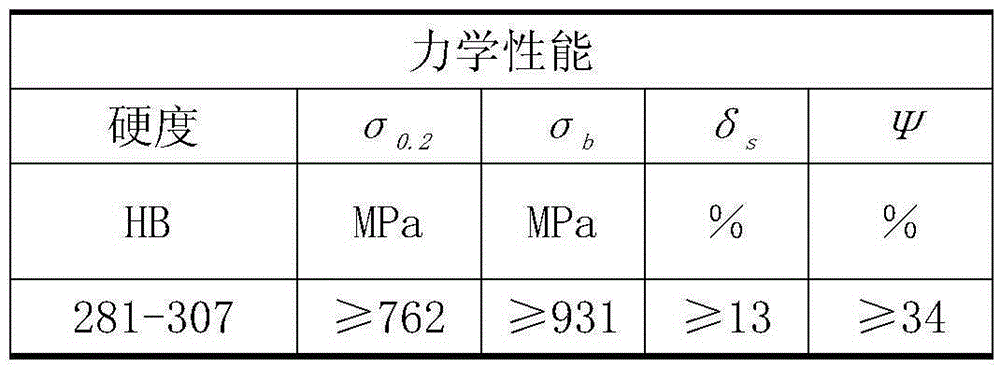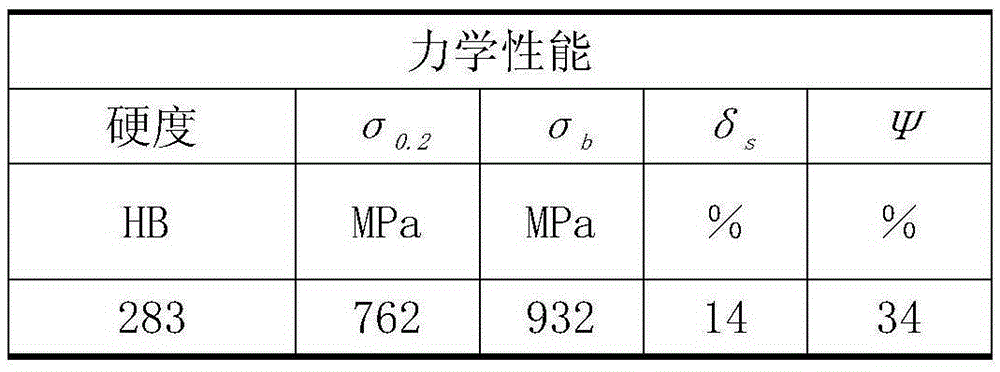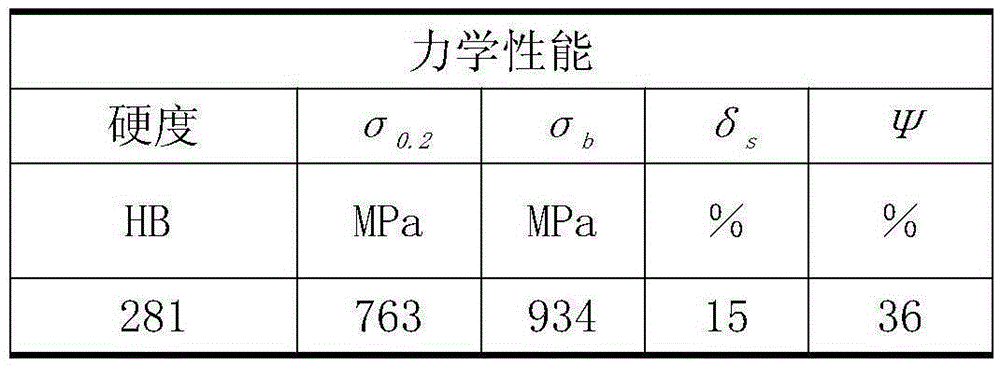A kind of corrosion-resistant steam turbine blade and its production process
A steam turbine blade and production process technology, applied in the direction of blade support components, mechanical equipment, manufacturing tools, etc., to achieve the effect of weakening the segregation of alloy elements and improving the impact toughness
- Summary
- Abstract
- Description
- Claims
- Application Information
AI Technical Summary
Problems solved by technology
Method used
Image
Examples
Embodiment 1
[0048] A corrosion-resistant steam turbine blade provided in this embodiment has the following mass percentages of chemical components: C: 0.31%, Si: 0.11%, Mn: 0.69%, Ni: 0.61%, Cr: 96%, V: 0.15%, Nb: 0.16%, Cu: 0.07%, Al: 0.22%, Ti: 0.13%, Sb: 0.77%, Co: 0.82%, S: 0.03%, P:: 0.01%, rare earth metal: 0.09%, and the balance is Fe;
[0049] The chemical composition mass percentage of rare earth metals is: cerium: 7%, praseodymium: 8%, neodymium: 14%, gadolinium: 7%, dysprosium: 4%, europium: 1%, terbium: 11%, holmium: 6%, Yu The amount is lanthanum.
[0050] Terbium: 10%, holmium: 4%, and the balance is lanthanum.
[0051] The production process of the corrosion-resistant steam turbine blade provided in this example is carried out according to the following procedures: hot forging→annealing→blade mechanical processing→stress relief heat treatment→quenching and tempering heat treatment→surface strengthening heat treatment→physical and chemical inspection→ultrasonic flaw detect...
Embodiment 2
[0060] A corrosion-resistant steam turbine blade provided in this embodiment has the following mass percentages of chemical components: C: 0.29%, Si: 0.12%, Mn: 0.72%, Ni: 0.62%, Cr: 9.7%, V: 0.16%, Nb: 0.18%, Cu: 0.05%, Al: 0.23%, Ti: 0.14%, Sb: 0.75%, Co: 0.87%, S: 0.0:2%, P≤0.02%, rare earth metal: 0.12%, balance is Fe;
[0061] The chemical composition mass percentage of rare earth metals is: cerium: 8%, praseodymium: 6%, neodymium: 15%, gadolinium: 5%, dysprosium: 2%, europium: 3%, terbium: 9%, holmium: 5%, Yu The amount is lanthanum.
[0062] The production process of the corrosion-resistant steam turbine blade provided in this example is carried out according to the following procedures: hot forging→annealing→blade mechanical processing→stress relief heat treatment→quenching and tempering heat treatment→surface strengthening heat treatment→physical and chemical inspection→ultrasonic flaw detection→clean packaging; wherein:
[0063] After hot forging, the temperature i...
Embodiment 3
[0071] A corrosion-resistant steam turbine blade provided in this embodiment has the following mass percentages of chemical components: C: 0.30%, Si: 0.13%, Mn: 0.73%, Ni: 0.60%, Cr: 9.5%, V: 0.17%, Nb: 0.17%, Cu: 0.06%, Al: 0.21%, Ti: 0.15%, Sb: 0.76%, Co: 0.88%, S: 0.0:25%, P: 0.015%, rare earth metal: 0.11%, balance is Fe;
[0072] The chemical composition mass percentage of rare earth metals is: cerium: 9%, praseodymium: 7%, neodymium: 13%, gadolinium: 6%, dysprosium: 3%, europium: 2%, terbium: 10%, holmium: 4%, Yu The amount is lanthanum.
[0073] The production process of the corrosion-resistant steam turbine blade provided in this example is carried out according to the following procedures: hot forging→annealing→blade mechanical processing→stress relief heat treatment→quenching and tempering heat treatment→surface strengthening heat treatment→physical and chemical inspection→ultrasonic flaw detection→clean packaging; wherein:
[0074] After hot forging, the temperatu...
PUM
| Property | Measurement | Unit |
|---|---|---|
| hardness | aaaaa | aaaaa |
Abstract
Description
Claims
Application Information
 Login to View More
Login to View More - R&D
- Intellectual Property
- Life Sciences
- Materials
- Tech Scout
- Unparalleled Data Quality
- Higher Quality Content
- 60% Fewer Hallucinations
Browse by: Latest US Patents, China's latest patents, Technical Efficacy Thesaurus, Application Domain, Technology Topic, Popular Technical Reports.
© 2025 PatSnap. All rights reserved.Legal|Privacy policy|Modern Slavery Act Transparency Statement|Sitemap|About US| Contact US: help@patsnap.com



